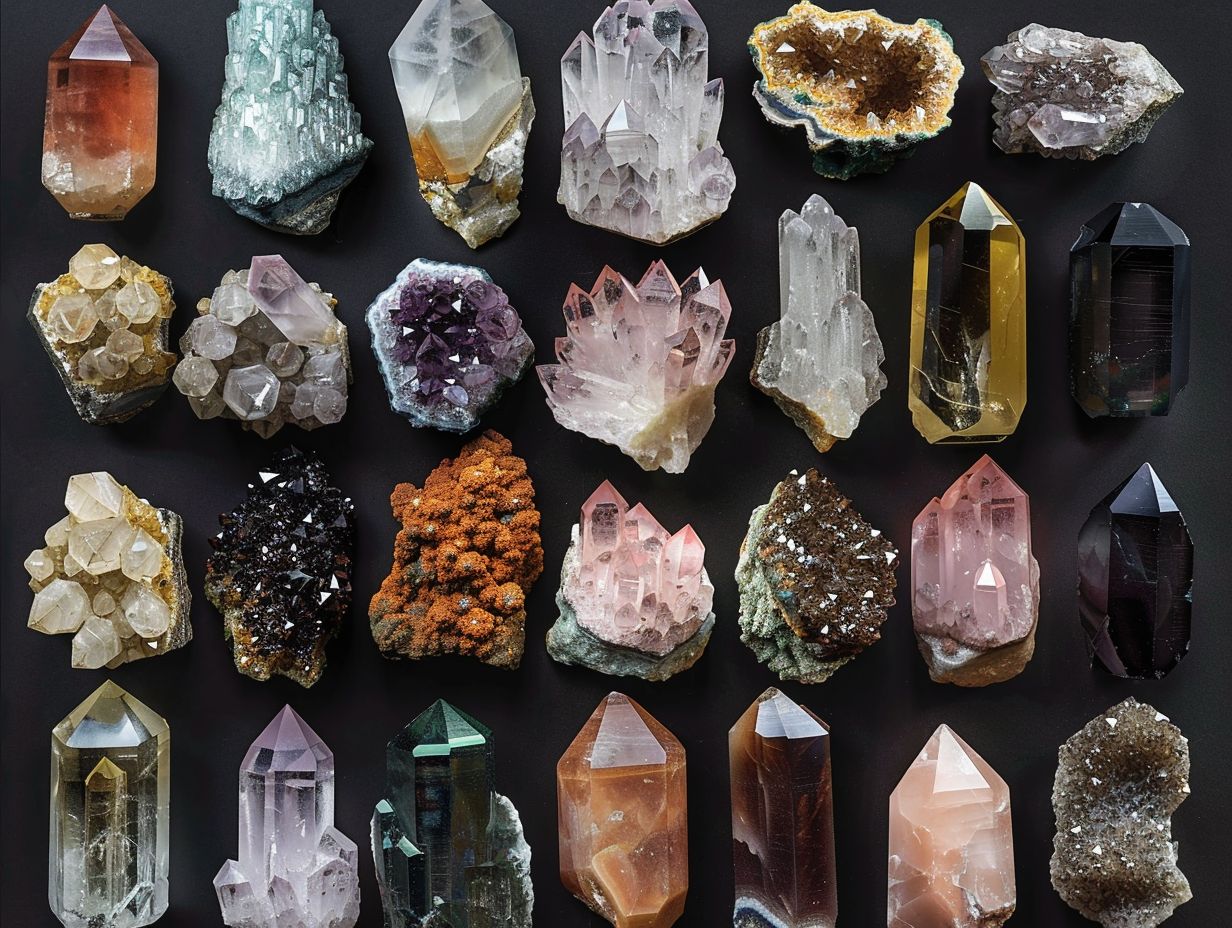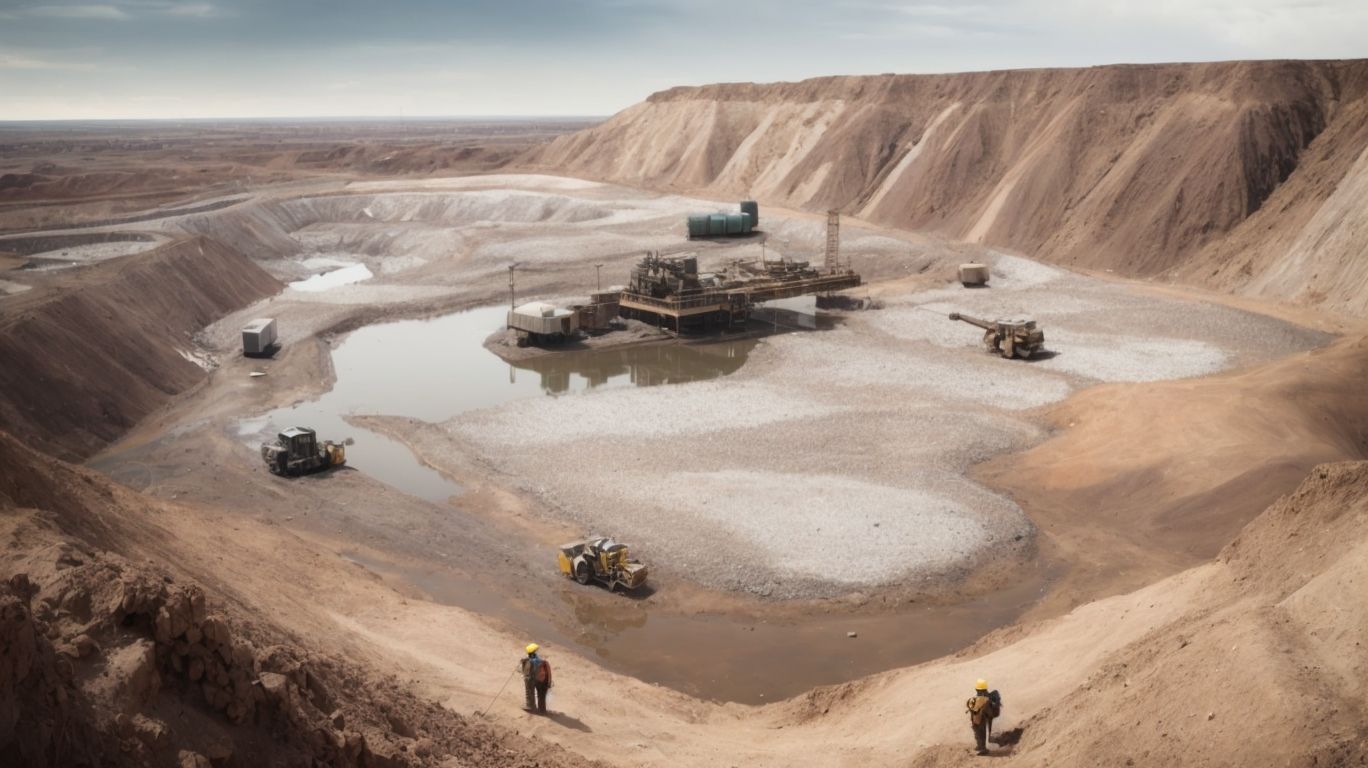
The Complete Guide to Amethyst Mining: Techniques and Locations
Are you fascinated by the beauty of amethyst and curious about how this stunning gemstone is mined?
In this comprehensive guide, we will explore the history of amethyst mining, various techniques used to extract this precious stone from the earth, and the top mining locations around the world.
From open pit mining to underground excavation, we will delve into the process of prospecting, exploration, extraction, and processing of amethyst.
We will discuss the environmental impact and ethical considerations of amethyst mining, as well as provide valuable tips for enthusiasts looking to embark on their own mining adventures.
Join us on this journey to uncover the secrets of amethyst mining!
What is Amethyst Mining?
Amethyst mining involves the extraction of this mesmerizing gemstone from various geological formations.
This gemstone has been prized for its stunning purple hues and metaphysical properties, making it a sought-after crystal in jewelry making and spiritual practices.
The process of amethyst mining often requires miners to locate rich deposits within mines or in natural formations like geodes. Techniques such as underground mining, open-pit mining, and artisanal mining are commonly employed to retrieve the precious amethyst crystals.
For those interested in exploring the world of amethyst mining, it is recommended to research and connect with reputable mining companies or visit known amethyst mining regions such as Brazil, Uruguay, and Zambia.
History of Amethyst Mining
The history of amethyst mining dates back centuries, highlighting its cultural significance and value throughout different eras.
From ancient Egyptians using amethyst in their jewelry and burial rituals to Greeks and Romans associating it with royalty and protection, this gemstone has woven itself into the tapestry of many civilizations.
In folklore, amethyst was believed to possess mystical powers, such as warding off drunkenness and promoting clarity of mind. Its deep purple hue symbolized wisdom, strength, and spirituality, making it a sought-after gem among rulers and spiritual leaders.
The legacy of amethyst mining transcends time, connecting humanity’s past beliefs and traditions with its enduring beauty and allure.
Types of Amethyst Mining Techniques
Different techniques are employed in amethyst mining, ranging from traditional chiseling to modern drilling methods.
Excavation is another crucial method utilized in amethyst mining, where large areas of land are dug up to reach the gemstones. Miners also make use of advanced drilling techniques to access deeper amethyst deposits efficiently. Tools like jackhammers, explosives, and heavy machinery are often employed in the excavation process to break through hard rock layers. Specialized equipment such as drills with diamond-tipped bits are utilized to extract the amethyst crystals without causing damage. These various techniques and tools play a fundamental role in the successful extraction of amethyst gemstones.
Open Pit Mining
Open pit mining is a common technique for extracting amethyst, involving the excavation of deposits from surface-level mines.
In open pit mining for amethyst extraction, the process begins with identifying potential amethyst deposits through geological surveys and analysis. Once a suitable site is located, the mining operation kicks off by clearing vegetation and topsoil to expose the mineral-rich layers beneath. Heavy machinery such as excavators and dump trucks are then utilized to remove the overburden and reach the amethyst-bearing rock. This method allows for efficient extraction of amethyst while minimizing the need for extensive underground tunneling, making it a cost-effective and productive mining approach.
Underground Mining
Underground mining of amethyst involves navigating tunnels to access geodes and veins where these precious gemstones are found.
Working in these intricate underground tunnels requires miners to have specialized knowledge and skills in identifying promising geological formations that may contain amethyst deposits. Locating the right veins and geodes can be a painstaking process, as the gemstones are often nestled deep within rock formations.
Miners must carefully follow the veins through the underground maze, utilizing tools such as drills and explosives to extract the amethyst without damaging the valuable crystals. The challenging environment of underground mines necessitates a combination of precision, patience, and a deep understanding of the geological structures in order to successfully harvest these stunning gems.
Alluvial Mining
Alluvial mining involves the search for amethyst crystals in riverbeds and cracks, making it a unique and rewarding technique.
By carefully sifting through the sediment deposits and examining the geological formations along riverbanks, miners can uncover stunning amethyst specimens hidden within the earth. The humility and patience required in this practice are balanced by the exhilarating thrill of discovering a valuable gemstone in its natural habitat. Due to the natural erosion processes that occur in these waterways, amethyst crystals can be found in various sizes and shapes, adding to the excitement of the hunt. This hands-on approach to gemstone mining not only offers a direct connection to the Earth’s treasures but also allows for a deeper appreciation of the intricate beauty found within nature.
Top Amethyst Mining Locations in the World
Several regions around the world are renowned for their abundant amethyst deposits, with countries like Brazil, Zambia, Uruguay, Russia, and Madagascar being prominent on the map.
Each of these locations boasts unique characteristics that make them stand out in the amethyst mining industry. Brazil, for instance, is known for its deep purple and clear amethyst crystals, often found in large sizes, making it a favorite among collectors.
Zambia, on the other hand, produces amethyst known for its rich hues and high clarity. Uruguay is celebrated for its distinctive geodes, with deep purple crystals nestled within intricate formations. In Russia, amethyst mines yield gemstones with varying shades, from pale lavender to deep violet.
Madagascar, a relatively newer player in the market, is gaining recognition for its high-quality amethyst and unique color variations.
Brazil
Brazil stands out as one of the world’s leading producers of amethyst, with its diverse and amethyst-rich regions attracting miners and enthusiasts from around the globe.
Among the notable regions in Brazil known for their abundant amethyst deposits are the southern states of Rio Grande do Sul and Minas Gerais. In these regions, mining activities thrive, with miners meticulously extracting amethyst crystals from the earth. Brazilian amethysts are renowned for their deep purple hues and exceptional clarity, making them highly sought after in the gemstone market.
The geological formations in these regions contribute to the formation of high-quality amethyst, known for its beauty and durability. Brazil’s dominance in amethyst mining is a testament to the country’s rich mineral resources and skilled workforce.
Zambia
Zambia is renowned for its high-quality amethyst specimens, offering a diverse range of sizes and colors that attract both collectors and lapidary enthusiasts.
The rich mineral deposits in Zambian mines yield amethyst crystals known for their exceptional clarity and deep purple hues, making them highly coveted in the gemstone market. Due to the unique geological composition of the region, Zambian amethysts showcase variations in color, ranging from pale lilacs to intense violets, appealing to individuals seeking distinct and vibrant gemstones for their collections or artistic creations. Lapidary artists often praise the consistency and brilliance of Zambian amethyst, which allows them to produce exquisite faceted gems and intricate jewelry pieces.
Uruguay
Uruguay is famous for its uniquely shaped amethyst crystals, often characterized by intriguing inclusions that add to their aesthetic appeal.
These mesmerizing crystals from Uruguay have long captivated gemstone enthusiasts and collectors alike. The distinctive formations and beautiful shades of violet found in Uruguayan amethyst make them highly sought after in the industry. Geologists attribute the remarkable quality of these crystals to the geological conditions in Uruguay, particularly in the Artigas region where they are predominantly mined.
The presence of iron in the soil is said to be one of the key factors contributing to the deep coloring and unique patterns observed in Uruguayan amethyst. As a result, these crystals stand out for their exceptional beauty and are considered prized possessions in the world of gemstones.
Russia
Russia boasts significant deposits of rough amethyst gems, which are highly sought after for their potential in faceting and creating exquisite jewelry pieces.
The rich violet hues of Russian amethyst, varying from deep purples to delicate lilacs, make them desirable for jewelry designers looking to incorporate a touch of regal elegance into their creations. The unique geological conditions in regions such as the Ural Mountains have resulted in amethyst formations known for their clarity and color consistency, qualities that are especially prized in the gemstone industry. Russian amethyst’s durability and brilliance also make it a preferred choice for both traditional and contemporary jewelry designs, allowing artisans to showcase its beauty in intricate settings.
Madagascar
Madagascar is known for its amethyst crystals with exceptional clarity, perfect for polishing and enhancing the natural beauty of the gem.
These coveted amethyst crystals from Madagascar are revered in the mining industry for their stunning transparency and remarkable quality. Miners in Malagasy mines meticulously extract these precious gems, ensuring each crystal retains its pristine clarity. Skilled artisans employ specialized polishing techniques that bring out the full brilliance of the amethyst, adding to their allure in the market.
The high market value of Malagasy amethyst reflects the superior quality and expert craftsmanship involved in the mining and polishing processes, making them highly sought after by gem enthusiasts worldwide.
How is Amethyst Mined?
Amethyst mining involves a series of steps, starting from prospecting and culminating in the extraction and purification of these beautiful gemstones.
- The prospecting phase of amethyst mining typically begins with geological surveys to identify potential areas rich in amethyst deposits.
- Once a promising site is located, miners use tools such as shovels, picks, and explosives to extract the raw materials.
- Extraction techniques vary depending on the location and size of the deposit, with some mines employing underground tunneling while others opt for open-pit mining.
- The extracted amethyst then undergoes a rigorous purification process to remove impurities and enhance its color and clarity, ensuring the production of high-quality gemstones.
Prospecting
Prospecting for amethyst necessitates employing various methods to locate potential deposits and identify areas rich in these captivating gemstones.
- This crucial phase involves geological surveys to analyze the landscape for indicators of amethyst presence, including veins, faults, and rock formations associated with the gemstone’s formation.
- Miners may also use remote sensing techniques such as satellite imagery and drone surveys to scout promising locations from a bird’s-eye view.
- Ground-based methods like soil sampling and trenching are commonly employed to confirm the presence of amethyst and assess the quality of mineralization.
Despite the excitement of potential discoveries, prospectors face challenges like rugged terrains, unpredictable weather conditions, and the uncertainty of striking a profitable deposit, making this phase a blend of anticipation and risk.
Exploration
Exploration plays a crucial role in amethyst mining, involving the study of geological formations and the navigation of caves to access hidden amethyst deposits.
Geological studies provide valuable insights into the formation processes that give rise to amethyst deposits, guiding miners in their quest to locate these precious gems.
Cave exploration is a challenging yet essential aspect of amethyst mining, requiring specialized skills and equipment to traverse the underground labyrinths where amethysts are often found.
Understanding the geological context is key to identifying favorable conditions for amethyst formation, such as the presence of specific rock types and mineral compositions, which can help miners pinpoint potential sources of amethyst and plan their extraction strategies accordingly.
Extraction
The extraction process in amethyst mining often involves drilling techniques and tunneling to access gemstone-rich veins and pockets within geological formations.
- Drilling is a crucial step used to create boreholes into the earth’s surface to reach the amethyst deposits hidden deep beneath the ground. Miners utilize various drilling methods such as rotary drilling or core drilling to extract the gemstones.
- Tunneling, on the other hand, involves creating underground passages to access the amethyst veins within the geological formations. This process requires a meticulous approach to ensure the safety of miners and the preservation of the precious gemstones. Challenges like unstable rock formations and potential collapses can pose risks during the extraction process.
Processing
Processing of amethyst crystals involves various methods to enhance their quality, appearance, and value, making them suitable for various applications.
- One common method used in the processing phase of amethyst mining is heat treatment, which involves applying controlled heat to the crystals to improve their color and clarity.
- Another technique is irradiation, where the gems are exposed to radiation to alter their pigmentation. Gemologists may employ cutting and polishing processes to shape the crystals into desirable forms, revealing their unique patterns and hues.
These refining methods not only bring out the inherent beauty of amethyst but also increase their market desirability and value.
Environmental Impact of Amethyst Mining
The environmental impact of amethyst mining raises important ethical considerations regarding sustainability, conservation, and responsible mining practices.
Rampant amethyst mining can lead to habitat destruction, soil erosion, and water pollution, disrupting the delicate balance of ecosystems. The extraction process often involves the use of heavy machinery and chemicals, further exacerbating environmental degradation. Mining activities can alter landscapes, affecting not only the natural beauty of the surroundings but also the biodiversity of the area. These changes can have far-reaching consequences on communities that depend on the land for their livelihoods, potentially leading to social and economic upheaval.
Therefore, it is crucial for the mining industry to prioritize sustainable practices and adhere to strict ethical guidelines to minimize harm to the environment and local populations.
Ethical Considerations in Amethyst Mining
Ethical considerations in amethyst mining revolve around the responsible use of resources, fair labor practices, and community engagement to ensure sustainable practices.
By prioritizing ethical sourcing practices, companies in the gemstone industry can minimize environmental impact and support the well-being of those involved in the mining process. It is crucial to uphold transparency in the supply chain, from the mining sites to the market, to guarantee that workers are paid fairly and work in safe conditions. Community involvement plays a vital role in fostering positive relationships between mining companies and local inhabitants, ensuring that the benefits of mining are shared equitably among all stakeholders.
Tips for Amethyst Mining Enthusiasts
For amethyst mining enthusiasts, collecting tips and engaging in lapidary practices can enhance the overall experience of exploring these stunning gemstones.
- When it comes to collecting amethyst, it’s important to have the right tools such as a rock hammer, chisels, and a bucket for gathering your finds.
- Knowing where to look is also key – amethyst can often be found in geodes or pockets within rocks.
Once you have your specimens, learning lapidary techniques like cutting, shaping, and polishing can turn rough amethyst into beautiful gemstones. To further enhance your mining experience, consider joining a local rockhounding club or attending gem and mineral shows to connect with other enthusiasts.




No Comments